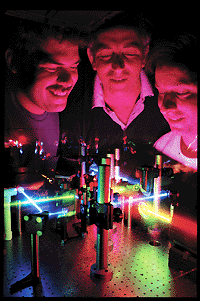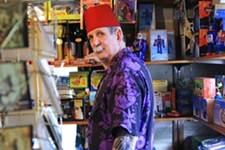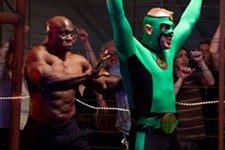Holograms of a Different Stripe
Zebra Imaging and the Future of Holograms
By Marc Savlov, Fri., Aug. 7, 1998
This is now.
|
|
Created and run by a trio of MIT Media Lab grads - Mark Holzbach, Michael Klug, and Alejandro Ferdman, Zebra makes its home in a semi-secluded warren of low-slung, beige, thoroughly nondescript office buildings set back from the road. The only indication of what goes on inside is the group's black-slashed Zebra logo above the door.
Inside, it's another story. A large main warehouse area serves as the company's showroom. Mounted on one side are a series of large tile panels that - strung together - make up the prototype for the world's first billboard-sized, true-color hologram. Standing thirty-odd paces back from it, the face, logo, and other elements ooze three-dimensionality as you move from left to right, changing perspective. The whole thing has an oddly surrealistic quality. Your brain isn't quite sure what to make of the whole thing.
Even more surreal is the severed Medusa head hologram measuring about two feet square that hangs above the door. Like older, non-digitally-created holos, this one radiates the familiar green and red striations as you move about. It is immensely, impressively cool, all the more so for being 10 years old, an experimental test project from back in the day.
Speaking of the billboard, Ferdman notes that it doesn't read well in the daylight - it would need to be placed in an indoor setting to be able to be seen properly by its audience. He mentions a project he'd like to do for the new airport, involving a fully hologrified view of Austin that deplaning travelers would be met with at disembarkation. For now, it's just a thought.
Before Zebra entered the relatively small field of holography, most holograms were limited not only by size but by color and the photographic plates used to create them. Because lasers play an integral role in the process, holography has remained a limited field at best.
"The largest ever made before this was one by two meters," says Ferdman, "and they've always been limited by the film size. We're not limited in that sense because we've found a way of tiling it together so you can make one of any size. The ones that were done before looked more like this" - he holds up a smallish, green-and-red, relatively nondescript hologram - "they were not true color, and when you moved the color changed."
Holograms have been around since Hungarian physicist Dennis Gabor stumbled across the concept back in 1948 while fiddling with the then-relatively new concept of electron microscopes. Later experiments with the emerging field of lasers led to ease of production, as well as using high contrast, fine-grained film that recorded visual information at 3,000 lines per millimeter.
In alleged layman's terms, and holding up a Coke can as a reference point, Ferdman describes Zebra's process - using Silicon Graphics' Infinite Reality workstations and a series of red, green, and blue lasers wholly created in-house - this way: "A coherent laser shines an object beam, bouncing off the Coke can, which spreads the beam which in turn hits the film. Then you have something else called a reference beam, which spreads the light out and sends it straight toward the film and creates an interference pattern between the object, and then that reference gets recorded on that film.
"Then, if you take that film away and look at it under a microscope, you have these tiny fringe patterns that when you shine a light through them at a certain angle, it will recreate the Coke can."
|
The pictures at top and bottom illustrate the 3-D nature of the hologram at center. photograph by Bruce Dye |
Zebra's methodology is light years ahead of traditional holography, however, in that they are making holograms of many, many different pictures of, say, that Coke can. "You could literally take 300 snapshots of that Coke can in a row and we can now make a hologram of each one of those pictures - and each hologram would be a slit on the finished product."
The billboard in question - made up of a dozen or so different tiles - isn't exactly cost-effective for Joe Small Businessman, at least not yet. With the creation of each separate tile budgeted at about $5,000, the group is now focusing on tripling the speed of their printer and designing a replicator that would allow them to mass-produce the tiles without the 24-to-36-hour time lag it now takes. "Then you're talking $400," says Ferdman
Prohibitive cost aside, Zebra has already fielded a number of requests and inquiries from several Fortune 10 companies, all of which at this point shall remain nameless. This despite having been in operation for only a year.
Up until last year, explains Ferdman, "Two of us were in Houston, and Mark was in Boston. I wanted to move to San Diego, Mark wanted to stay in Boston, so we decided we each get one veto power, so he vetoed San Diego, I vetoed Boston, everybody vetoed Houston, so then we were left with the rest of the states. We discussed San Francisco, Seattle, and Austin, and then we moved here about a year ago in July. This is much better than San Francisco. There's spice here."
As far as selecting a Hill Country location, Holzbach notes that the group had to go all over town in search of a place that was large enough to contain their in-house operations as well as being situated well away from any roads or railroad tracks whose vibrations might disturb the delicate nature of and positioning of the lasers.
A cramped, darkened room off Zebra's main hall holds the company's lasers, continually shooting light at a translator that then sends the laser beams onto a special photographic plate designed for the task by Dupont.
Amidst the steady whoosh, whoosh of the machinery, Ferdman explains that, "what's happening here is that it's recording a slit at a time, recording about 700 exposures. It's all automated. The big translator is moving about two millimeters, making over 90,000 separate exposures. Every time it moves, this big shutter opens, lets the laser light in, and exposes that one square."
For a physics and holography novice like myself, the effect is strangely disorienting. The air is perpetually sliced by the trio of lasers while complex mechanics and intransigent mathematics go on around me. Incomprehensible, yeah, but I have to admit it all looks cool as hell.
Central to the creation of Zebra's holograms is the Dupont photo polymer that acts as the film onto which the laser's imaging is recorded. Produced in part at Dupont Photomasks here in Central Texas, Holzbach enthuses: "It's a real revolutionary material. Dupont just came out with the full color version - they've had the monochromatic version for a while. This isn't the most common material that holographers have used, either - they've tended to use silver halide, which is also used in conventional black-and-white photo chemistry. It used to be made by Kodak and Agfa, but those materials are harder to come by. I don't think it was such a profitable business for them."
And what about those free-standing sci-fi holograms mentioned in the beginning? Impossible, says Ferdman.
"Light just doesn't turn in the air, it needs something behind it. So Princess Leia, when somebody's looking at her head, they're looking through space into nothing behind her, and that's just impossible. If you draw a line from your eye to what you're looking at, there's always something behind it. Now, you could have animation, where as you move the hologram's mouth could be talking to you. And it is theoretically possible to have an interactive or full-motion hologram as well. It's just that the amount of information that you would need to transmit or refresh is very, very high."
Clearly, the killer pornographic apps are a ways off.
For marketing, advertising, and visualization, Zebra's digital holograms and their work on a home desktop version is nothing short of revolutionary. For designers working on computers, the transformation of their work from a two-dimensional screen to a three-dimensional hard copy is a dream come true.
"Human visual communications of any kind - a lot of it is three-dimensional," adds Holzbach. "Anytime anyone wants to visualize anything, or have a record to show someone else. There's tremendous applications in portraiture in and of itself. What about in your house, you have these picture frames, right? Why not have them be 3-D instead of 2-D? Security. Medical industries. And the one we're attacking first: design and analysis, and then advertising. And, of course, product design. If someone designs this new vacuum cleaner, or this new seat, or this new Rollerblade, and they really want to see what it would look like, they can print out a hologram and really look at it from all angles."
Ferdman concurs: "The advantages with this are that we can do any size, we can do someone's face, things the old-style holograms could never do. Our goal is to get it to be like a peripheral device off of your computer, so somebody who's designing something in 3-D just pushes a button and gets a printout of a hologram. That should be feasible in about two years. We want to put this in everybody's hands.
"There's only 10 people or less in the world that could do something like this and, hey, we've got three of them."











